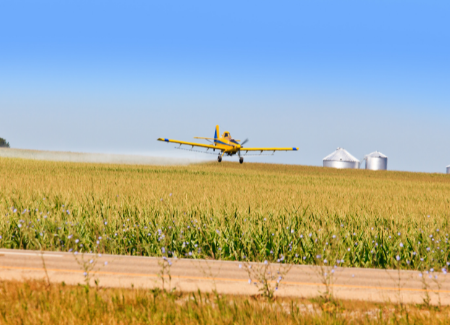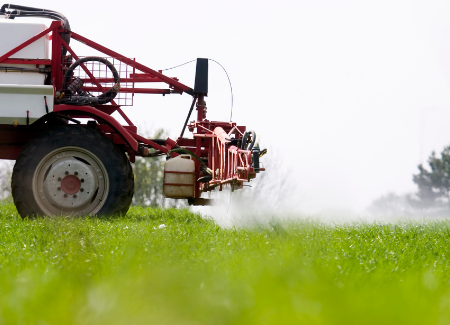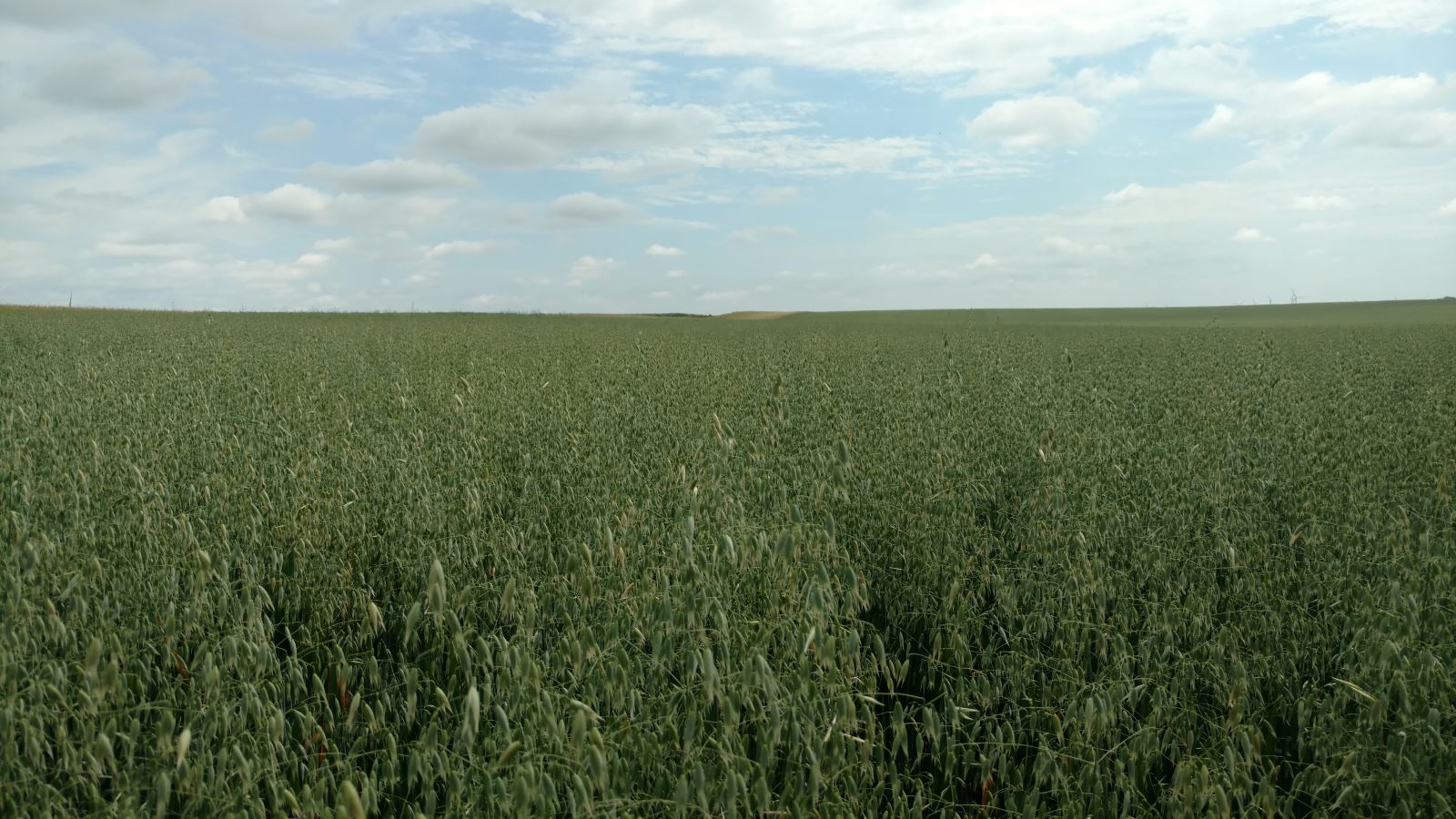What nitrogen monitoring can teach us about managing pesticides
posted
by Guest Blogger on Tuesday, February 8, 2022
Guest blog post by Audrey Tran Lam, Environmental Health Program Manager at UNI’s Center for Energy & Environmental Education.
What I’m about to say won’t surprise IEC supporters in the least — Iowa is struggling with serious environmental health issues, many of them water-related. From nitrates to harmful algal blooms, from pesticide trespass to soil erosion, Iowa’s simple corn-bean rotation is inherently leaky, resulting in a cascade of issues that not only impact people but also the planet.
The point at which agriculture explicitly creeps into the public health sphere is when it comes to drinking water quality--runoff from synthetic nitrogen spikes nitrate concentrations in drinking water.
.jpg) I get it: nitrogen is easy to talk about because we monitor it so closely. Water utilities are required to keep nitrates under the EPA’s Maximum Contaminant Level (MCL) of 10 mg/L to prevent acute incidence of nitrate exposure. As Iowans, we’re likely familiar with “blue baby syndrome” caused by “acute” exposure to nitrates in drinking water. However, we may be less familiar with other health impacts that more chronic, “safe” levels exposure to nitrates can cause, namely cancer. Some public health professionals, myself included, think that a nitrate MCL of <5 mg/L is more protective of public health.
I get it: nitrogen is easy to talk about because we monitor it so closely. Water utilities are required to keep nitrates under the EPA’s Maximum Contaminant Level (MCL) of 10 mg/L to prevent acute incidence of nitrate exposure. As Iowans, we’re likely familiar with “blue baby syndrome” caused by “acute” exposure to nitrates in drinking water. However, we may be less familiar with other health impacts that more chronic, “safe” levels exposure to nitrates can cause, namely cancer. Some public health professionals, myself included, think that a nitrate MCL of <5 mg/L is more protective of public health.
Okay, so nitrogen gets a lot of attention when it comes to drinking water. But what about other agricultural contaminants, like pesticides?
The term “pesticide” is an umbrella term that refers to a chemical that is designed to deter or eliminate pests. A “pest” can refer to any number of things--a dandelion, termites, a rat, etc. so “herbicide,” “insecticide,” “rodenticide,” “fungicide,” (even “biocides!”) are examples of pesticides.
 Some pesticides are applied directly to genetically modified crops that are engineered to be resistant to chemicals that would otherwise kill them, some are applied to seed and planted in the soil, and some are applied via airplane. Because of the sheer volume these chemicals are applied to the millions of acres of corn and soybeans in Iowa, pesticides will find their way into the environment due to drift, water solubility, and other pathways.
Some pesticides are applied directly to genetically modified crops that are engineered to be resistant to chemicals that would otherwise kill them, some are applied to seed and planted in the soil, and some are applied via airplane. Because of the sheer volume these chemicals are applied to the millions of acres of corn and soybeans in Iowa, pesticides will find their way into the environment due to drift, water solubility, and other pathways.
Like nitrogen, pesticides are used ubiquitously in the state; close to 50 million pounds of herbicides are applied in Iowa annually to speak nothing of insecticides or fungicides.
 The truth is that while we know enough about pesticides to be genuinely concerned about acute and chronic exposure to human health (evidence suggests that pesticides can disrupt human hormones and gut microbiota leading to metabolic disorders; some have been linked to cancer development, and others have direct impacts on children’s neurobehavioral health), we aren’t measuring their occurrence in Iowa waterways the way we measure nitrogen, so painting a picture of our exposure in recreation or public and private drinking water is difficult to do. And monitoring for pesticides can be expensive and tricky; some of them break down quickly in the environment into degredates (also known as “daughter compounds”) that may be as harmful as the parent compound.
The truth is that while we know enough about pesticides to be genuinely concerned about acute and chronic exposure to human health (evidence suggests that pesticides can disrupt human hormones and gut microbiota leading to metabolic disorders; some have been linked to cancer development, and others have direct impacts on children’s neurobehavioral health), we aren’t measuring their occurrence in Iowa waterways the way we measure nitrogen, so painting a picture of our exposure in recreation or public and private drinking water is difficult to do. And monitoring for pesticides can be expensive and tricky; some of them break down quickly in the environment into degredates (also known as “daughter compounds”) that may be as harmful as the parent compound.
Examples of robust pesticide monitoring programs in other states exist, and a great example lies with our neighbors to the north. Check out Minnesota’s Department of Agriculture’s Agricultural Monitoring and Assessment program. MDA routinely monitors for persistent pesticides that still show up in groundwater and private wells, and provides Minnesotans with information about how to keep their water safe.
While Iowa can’t currently boast a pesticide monitoring program as comprehensive as in Minnesota, we do have a wealth of water quality monitoring experts. These experts care deeply about both Iowa and what we don’t know about pesticide fate and transport in water.
What’s more, these experts, faced with limited resources and staff, are working together to make water quality information more available, accessible, and transparent to all Iowans through their work. They also recognize that a multidisciplinary approach to tracking pesticides will require collaboration between the fields of agronomy, public health, chemistry, and toxicology.
One of the spaces where this collaboration and networking is happening is through the statewide Pesticides & Public Health Working Group facilitated by the Farming for Public Health initiative at the Center for Energy and Environmental Education (CEEE). The purpose of this working group is to learn from each other, build a community around information about pesticides within the state, and work collaboratively to reduce their application in Iowa. (If you want to learn more about the Pesticides & Public Health Working Group, head to our website. Are you or someone you know interested in attending these meetings regularly? Send me an email.)
In public health, we’re taught to be systems thinkers and to seek upstream solutions--solutions that address multiple problems at once. When it comes to nitrogen and pesticide runoff, the upstream solution is to change how we farm the land. We don’t have to wait to know exactly what’s in our water to clean it up.
 Long-term studies at Iowa State University have shown that changing the way we farm the land - simply by adding a third rotation such as oats or alfalfa - can result in:
Long-term studies at Iowa State University have shown that changing the way we farm the land - simply by adding a third rotation such as oats or alfalfa - can result in:
- Higher yields
- 88% reduction in herbicide use
- 80% reduction in synthetic fertilizer use
- 50% less fossil fuel use
- Significant reduction in soybean diseases
- Better soil health and retention (which means less erosion and more resilience to droughts and floods)
- Significant reductions in nutrient (nitrogen and phosphorus) pollution in our waters, diminishing the risk of cancers and threats of harmful toxins produced by blue-green algae
The farmers involved in these practices are public health heroes. They are putting agronomic science into action, employing evidence-based practices on their farms to improve the health of their land and their communities. Public health practitioners, health care providers, water utilities, and Iowans should acknowledge and support these innovative farmers and their work. They’re truly farming for public health and the public good.
The solutions to address the pesticide problems in the state can also address the nitrogen problems we face. We don’t have to wait for water quality monitoring programs to act on what we know works to make our state a healthier place.
About the Author
 Audrey E. Tran Lam, MPH, is Environmental Health Program Manager at UNI’s Center for Energy & Environmental Education.
Audrey E. Tran Lam, MPH, is Environmental Health Program Manager at UNI’s Center for Energy & Environmental Education.
She manages the statewide Farming for Public Health initiative and facilitates the Pesticides & Public Health working group. She can be reached at audrey.tranlam@uni.edu.
- clean water
- drinking water
- member org
- nitrate pollution